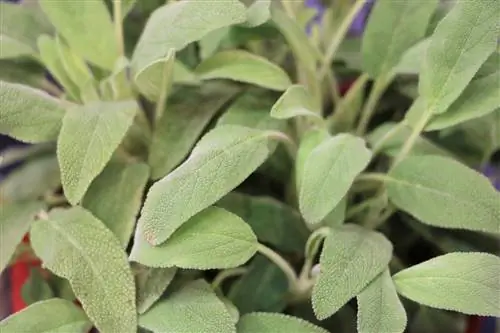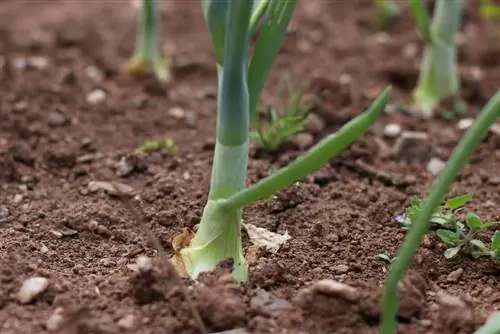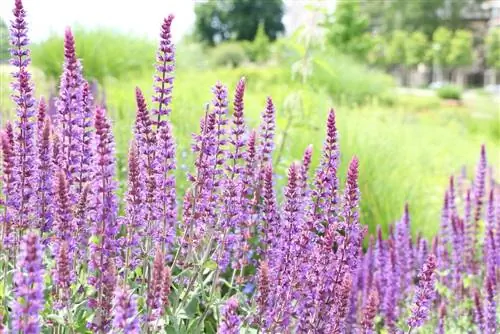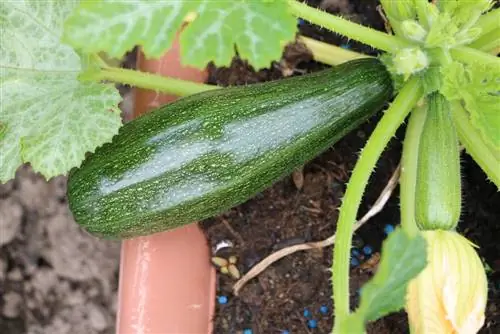- Author admin [email protected].
- Public 2023-12-17 03:39.
- Last modified 2025-01-24 12:45.
Sage loves calcareous soil, the plants are hardy and can remain outdoors. But the herb also looks beautiful in pots and buckets on the balcony and windowsill, the flowers are very decorative. And sage is indispensable as a culinary herb. Sage bushes have a deterrent effect on caterpillars, lice and snails - this suggests keeping the plants between more susceptible species in the garden, for example as a border for vegetable beds. Only spider mites and powdery mildew sometimes bother sage.
Location
Sage comes from Mediterranean countries and is actually not native to Western and Central Europe. However, the plants are very adaptable and if they are given a sunny, warm location with lots of sun, they will thrive. This applies both outdoors and for cultivation on the windowsill: south-facing windows are ideal.
Soil and substrate
Sage plants need calcareous soils that are permeable to water, do not become waterlogged and do not have too high a humus content. Outdoors, it is recommended to loosen the substrate with coarse pebbles. A drainage layer made of broken clay or pebbles must be incorporated into the pot to avoid waterlogging.
Repotting
If sage is kept in a pot, it is repotted once a year, the substrate is renewed and a larger planter is used. This guarantees that the roots receive the space they need and the plant is supplied with fresh nutrients. The drainage in the pot is created with shards of pottery or pebbles, and in the first few days after repotting the plant needs sufficient moisture to grow well. The optimal time for repotting is spring, so early that the sage has not yet sprouted again after the winter dormancy. Sage is generally not transplanted annually outdoors.
Watering and fertilizing
Sage can easily survive longer dry periods, but it does not tolerate waterlogging. Plants from the Mediterranean region do best with moderate watering, and sage does not need much fertilizer. The plants are used to poor, chalky soils and can cope with well-rotted compost, but do not like fresh manure. Since it is a culinary herb that is grown for consumption and infusions, sage should always be fertilized with natural, if possible organic, fertilizer. A moderate amount of compost in spring and autumn is sufficient when kept outdoors. In general, sage needs potassium and nitrogen - in the pot it can be carefully fertilized every four weeks from March.
Short shoots, cut back, harvest
Sage doesn't need much care overall. It is sufficient if the shoots that are not yet woody are cut back in the spring; a second cut is not necessary. Only the leaves are suitable for harvesting and use in the kitchen, but they are not cut individually; the non-woody shoots are also removed completely or, if necessary, one or two branches are removed.
Wintering
Sage is partially hardy, so it can remain outdoors under certain conditions. This is only possible if the sage grows in a protected, sunny spot. The plants should be covered with pine branches or brushwood. The sage is only cut back a little in autumn and the green leaves remain visible. The shoots should be shortened by about half, although if possible you should not cut into the woody shoots. If sage overwinters in a pot or bucket, the container is placed on a Styrofoam plate. The container is wrapped with jute bags or fleece to keep the frost away. And of course the sage is also covered from above. It's a lot of work, and sometimes this effort is in vain; the sage still doesn't make it through the winter. If these measures are too uncertain for you, you can take the sage indoors in the fall and let it overwinter in a cool, not too bright room. This winter break should be as short as possible, because in darker rooms sage does not have enough light and will sprout again more quickly due to the higher temperature. These bright, very soft shoots are susceptible to pests and diseases, they are undesirable.
Bloom
The sage blooms in the garden between June and August. If you want to harvest the herbs, it is better not to let them bloom, because the plant puts all its energy into the development of buds, flowers and seeds, so that the leaves are less aromatic. The buds are removed as early as possible so that the plant continues to sprout leaves and grow.
The flower is very decorative. If the leaves of the sage are not needed and you still want to get seeds, it is better to let the plant flower. Because you can easily propagate sage from the seeds.
Propagate
Sage is sown outdoors from April and in the greenhouse from March. The seeds are placed on the moist soil, pressed down slightly and covered with a little soil. With adequate watering, sage will germinate in about seven to twenty-one days. If the sage germinates in the greenhouse, it is placed outside around mid-May. The plants should be about 35 cm apart from each other. It is easier to propagate using cuttings or seedlings. They are simply placed outdoors or in a pot and usually grow without any problems. Seedlings are obtained in autumn when the shoots of the sage are cut back by about half for the winter.
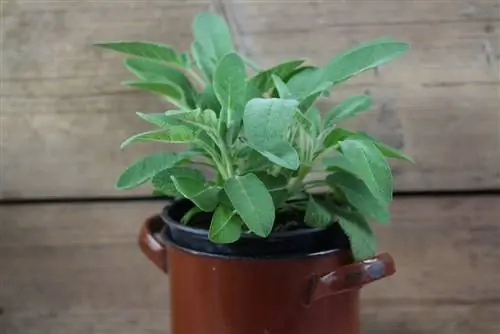
Tip:
Sage works very well as a partner in mixed cultures. The bushes get along excellently with carrots, fennel, lettuce and beans. The leafy vegetables and salads that are popular with snails in particular benefit from the partnership - the sage keeps the pests away.
Frequently asked questions
Spider mites have settled on my sage. What can I do?
Spider mites attach themselves to the underside of the leaves and spin a very stubborn web to protect themselves. The females can lay hundreds of eggs - spider mites are difficult to get rid of. Chemical warfare agents are generally not recommended for herbs; after all, the leaves of the plants should be consumed safely. Predatory mites are biological pest controllers; they simply eat the spider mites and leave the plants alone. If there are no more spider mites, the predatory mites also migrate. Apart from that, there are products based on rapeseed oil that prevent spider mites from reproducing and, at least in the short term, decimate the population. Sometimes it is enough (if the infestation is small) to wrap the plants in cling film (only the above-ground part) and put them outdoors in this way. It is watered from below, and in the extremely humid climate under the film the mites die.
My sage is affected by mildew. Will I get rid of it?
Most of the time, powdery mildew, a fungal culture, cannot be removed using biological means. A mixture of milk and water can be sprayed for very small infestations, but this is often not enough. Mildew lives on living plants - the sage should be disposed of in the compost, either just the few affected areas or, in the case of large-scale infestation, the entire plant, because mildew spreads quickly.
Can you eat all types of sage?
No, there are actually some species that are only bred for decoration and for the beautiful flowers. These species are not edible. In the plant trade, the edible species are labeled as such.
What you should know about sage in brief
- The sage bush grows to 40-50 cm tall and grows best in a sunny location. A rather poor soil is enough for him.
- You should plant sage in fall or spring. Attention: Since the old plants become woody easily, new plants should be planted approximately every five years.
- The herb is collected in May, as sage blooms in June.
- With sage, you only harvest the shoot tips; you can do this - because sage is evergreen - even fresh in winter.
Application
- Sage leaves are used for seasoning. You can use them fresh, boil them or fry them.
- Sage tea often helps with a sore throat. To do this, simply pour hot water over the sage and let it steep for about 10 minutes.
- However, sage is also used during pregnancy (to stop the flow of milk - when weaning) or for menstrual problems.
- Attention: If used during pregnancy, please consult your doctor first if necessary!
- If you burn sage leaves, you can banish unpleasant smells from the room. Feng Shui uses this method to transform chi into positive energy.
Cutting
- If the sage has a nice sunny location in your garden, it will develop vigorously in the summer.
- Do not wait until the subshrub develops into a semi-woody structure. Prune your sage regularly starting in March!
- If you want to prune your sage that was planted last year so that it can sprout again, you can do this in spring.
- During the summer, always prune when you can use sage in the kitchen.
- And in the fall, the stock is harvested for the winter with the cut; when cut short, the sage usually survives the winter better.
- It is important with this type of woody perennials that you always stop cutting just above the fresh shoots.
- Sage can tolerate cutting into old wood, but it then takes a while until it gets going again from these interfaces.
- Any more radical pruning is actually an emergency measure; it is better if you encourage your sage to branch out profusely from the start.
Care and overwintering
- If your sage feels comfortable in its sunny location, it hardly needs any special care.
- You should just make sure that you only water it when the top layer of soil has already dried.
- The shrub, which is used to barren soils, does not like waterlogging. Fertilizer is also unnecessary, it could even make the sage lazy to bloom.
- When it comes to overwintering, you have the choice: either cut it back and leave it outside over the winter - in harsh locations with winter protection.
- You can also simply dig up your sage, put it in a pot and bring it into the house if it regularly gets really cold where you live in winter.

